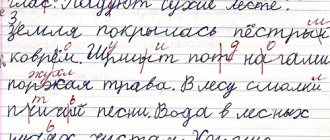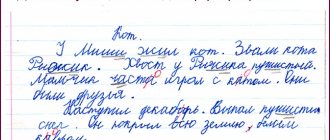When a child begins to study in primary school, parents may be surprised to learn from the teacher that their child is experiencing serious difficulties with writing. Quite often, a new student makes many specific mistakes when writing words and, despite all his efforts, completes written assignments extremely slowly and sloppily. This is how a specific speech therapy pathology manifests itself – dysgraphia.
How to understand that a child has dysgraphia?
At its core, dysgraphia is a fairly common speech therapy defect in which written speech is impaired. This deviation is diagnosed in almost 30% of students. The presence of pathology in younger schoolchildren is associated with insufficient maturity of the mental system, as well as with a lack of consistency in the functioning of the brain lobes, which are responsible for the perception of information and fine motor skills of the hands.
Most often, the presence of dysgraphia is detected precisely at the beginning of schooling, when purposeful mastery of these skills occurs. In copybooks, the child makes phonetic errors of various types.
For example, it does not distinguish between letters that sound similar (“z” and “s”, “zh” and “sh”, “t” and “d”), adds unnecessary ones or skips necessary ones (“vesena” instead of “spring”, “trlka” " instead of "plate"), writes words together, etc.
At first, looking at the work of such a student, the teacher can conclude that he is lazy, irresponsible or illiterate. However, the reason lies much deeper. Such children diligently approach the task, however, for certain reasons, they cannot cope with the correct spelling of words.
For example, if we compare the mistakes of two students in writing the word “sentence”, then a child with simple ignorance of grammatical rules will write “addition”, and a child with dysgraphia will write “branching”. It is in such nuances that the presence of this pathology is visible.
Moreover, as a rule, dysgraphics are written very sloppy and crookedly. No matter how hard they try, they cannot keep up with their faster classmates, which causes constant irritability, dissatisfaction, depressed mood and low self-esteem. Moreover, quite often dysgraphia is supplemented by dyslexia (difficulties with reading) and speech disorders.
Classification of dysgraphia
- Acoustic (as a result of impaired phonemic perception).
- Articulatory-acoustic (in case of violation of sound pronunciation).
- Optical (associated with insufficiency of visual-spatial functions).
- Agrammatic (as a consequence of the impaired lexical and grammatical structure of oral speech).
- Dysgraphia due to impairment of language analysis and synthesis.
There is a nonspecific type of dysgraphia as a secondary defect. Primary disorders are pedagogical neglect, mental retardation, and delayed mental development.
It is often not possible to classify written speech disorders of a particular schoolchild as one of the known forms of dysgraphia due to the combinatorial nature of the pathology. Most often, there is a combination of a problem caused by the immaturity of language analysis and synthesis, and optical dysgraphia, in traditional terminology.
The concept of optical dysgraphia is inappropriately expanded to include writing disorders caused by insufficient kinetic basis of movements (mixing the letters b-d, p-t, l-m, x-zh, i-u, o-a, i-sh and some others). It is these errors that occur in students’ work much more often than mixing letters based on optical similarity.
Agrammatic dysgraphia is considered as a manifestation of general speech underdevelopment, according to which its correction is based on work to overcome oral speech underdevelopment using well-known traditional methods. In mass schools, this form is relatively rare and is associated, first of all, with the situation of forced bilingualism.
Dysgraphia statistics:
Main types of dysgraphia
Based on the characteristics of written disorders, experts identify five main types of dysgraphia. Let's take a closer look at how each of them manifests itself.
Acoustic dysgraphia
The child pronounces words correctly and does not experience hearing difficulties, however, when displaying information on paper, he replaces letters with ones that sound similar to them. These can be vowels or consonants, voiced or unvoiced, hissing or whistling. The student may also have difficulty representing letters correctly in soft form.
For example: “dikdand” - “dictation”, “masina” - “car”, “syplenok” - “chicken”, as well as “lublu” - “love”, “frock coat” - “frock coat”.
Articular-acoustic dysgraphia
Problems with spelling words are the result of incorrect pronunciation. A child who has speech therapy defects and makes mistakes during a conversation cannot correctly transfer sounds onto paper. That is, as the student speaks, so he writes. Accordingly, if the baby has incorrect pronunciation, then the spelling will be the same. For example: “lyba” - “fish”, “labota” - “work”, “zayas” - “hare”, “sapka” - “hat”, “nasa skola” - “our school”.
Optical dysgraphia
The child has difficulty visually representing written characters. The student can assign additional details, loops, ticks or hooks to the letters, or lose the necessary elements. Mirror spelling of letters is also quite often observed, especially in cases where the student is left-handed.
Example: most often a child confuses the spelling of similar letters “i” - “sh”, “o” - “a”, loses elements of the symbols “” - “A” or displays them in a mirror image “E” - “Z”.
Types of dysgraphia mechanisms and symptoms (Table)
Dysgraphia is a partial specific disorder of the writing process that is not associated with intelligence. Dysgraphia is not the result of mental retardation. People with dysgraphia may not have intellectual deficits and may be developmentally normal in all other respects.
For the first time, A. Kussmaul pointed out reading and writing disorders as an independent pathology of speech activity in 1877.
The most reasonable is the classification of dysgraphia, which is based on the immaturity of certain operations of the writing process (developed by employees of the Department of Speech Therapy of Leningrad State Pedagogical Institute named after A.I. Herzen).
Table of types of dysgraphia
| Types of dysgraphia | Mechanisms | Symptoms |
| Articulatory-acoustic dysgraphia | Lack of differentiation of auditory perception, insufficient development of sound analysis and synthesis | Manifests itself in substitutions and omissions of letters corresponding to substitutions and omissions of sounds in oral speech. Most often observed with dysarthria, rhinolalia, dyslalia of a polymorphic nature. Sometimes letter substitutions remain in writing even after they are eliminated in oral speech (one can assume that during internal pronunciation there is not sufficient support for correct articulation, since clear kinesthetic images of sounds have not yet been formed). |
| Acoustic dysgraphia (based on phoneme recognition impairments) | There is no consensus on the mechanisms of this type of dysgraphia. This is due to the complexity of the phoneme recognition process. Some authors (S. Borel-Maisonni, O.A. Tokareva) believe that the basis for substitutions of letters denoting phonetically similar sounds is the blurredness of auditory perception, the inaccuracy of auditory differentiation of sounds. Other authors (Sobotovich E.F., Gopichenko E.M.), who studied writing impairments in mentally retarded children, associate letter substitutions with the fact that during phonemic recognition children rely on articulatory signs of sounds and do not use auditory control. Some authors associate the replacement of letters in a letter with phonemic underdevelopment, with unformed ideas about the phoneme, with a violation of the operation of choosing a phoneme (R.E. Levina, L.F. Spirova). Correct writing requires a sufficient level of functioning of all operations of the process of distinguishing and selecting phonemes. If any link is violated (auditory, kinesthetic analysis, phoneme selection operation, auditory and kinesthetic control), the entire process of phonemic recognition becomes difficult, which manifests itself in the replacement of letters in the letter. Therefore, taking into account the impaired operations of phonemic recognition, the following subtypes of this form of dysgraphia can be distinguished: acoustic, kinesthetic, phonemic. | Manifests itself in substitutions of letters corresponding to phonetically similar sounds. At the same time, in oral speech, sounds are pronounced correctly. Most often, letters denoting the following sounds are replaced: whistling and hissing, voiced and voiceless, affricates and components included in their composition (ch - t, ch - sch, ts - t, ts - s). This type of dysgraphia is also manifested in the incorrect designation of soft consonants in writing due to a violation of the differentiation of hard and soft consonants (“pismo”, “lubit”, “lizha”). Frequent mistakes are the replacement of vowels even in the stressed position, for example, o - y (tuma - “point”), e - i (les - “fox”). In its most striking form, dysgraphia based on impaired phoneme recognition is observed in sensory alalia and aphasia. In severe cases, letters denoting distant articulatory and acoustic sounds are mixed (l - k, b - v, p - k). In this case, the pronunciation of sounds corresponding to the mixed letters is normal. |
| Based on violations of language analysis and synthesis. | It is based on a violation of various forms of language analysis and synthesis: dividing sentences into words, syllabic and phonemic analysis and synthesis. The underdevelopment of language analysis and synthesis manifests itself in writing in distortions of the structure of words and sentences. The most complex form of language analysis is phonemic analysis. As a result, distortions of the sound-letter structure of the word will be especially common in this type of dysgraphia. | The most common errors are: omissions of consonants when they come together (dictation - “dikat”, school - “kola”); vowel omissions (dog - “sbaka”, home - “dma”); permutations of letters (path - “prota”, window - “kono”); adding letters (taskali - “tasakali”); omissions, additions, rearrangement of syllables (room - “kota”, glass - “kata”). For proper mastery of the writing process, it is necessary that the child’s phonemic analysis be formed not only externally, in speech, but also internally, in terms of representation. Violation of the division of sentences into words in this type of dysgraphia is manifested in the continuous spelling of words, especially prepositions, with other words (it is raining - “Idedosh”, in the house - “in the house”); separate spelling of the word (a white birch tree grows near the window - “belabe zaratet oka”); separate writing of the prefix and the root of the word (stepped - “stepped on”). |
| Ungrammatical (characterized in the works of Levina R.E., Kolpovskaya I.K., Lalaeva R.I., Yakovlev S.B.). | It is associated with underdevelopment of the grammatical structure of speech: morphological, syntactic generalizations. This type of dysgraphia can manifest itself at the level of words, phrases, sentences and texts and is part of a broader symptom complex - lexico-grammatical underdevelopment, which is observed in children with dysarthria, alalia and the mentally retarded. | In coherent written speech, children show great difficulties in establishing logical and linguistic connections between sentences. The sequence of sentences does not always correspond to the sequence of events described; semantic and grammatical connections between individual sentences are broken. At the sentence level, agrammatisms in writing appear: – in distortion of the morphological structure of the word, replacement of prefixes, suffixes (overwhelmed - “overwhelmed”, goats - “kids”); – changing case endings (“many trees”); – violation of prepositional constructions (above the table - “on the table”); – changing the case of pronouns (near him - “about him”); – number of nouns (“children are running”); violation of agreement (“white house”); There is also a violation of the syntactic design of speech, which manifests itself in difficulties in constructing complex sentences, omitting sentence members, and violation of the sequence of words in a sentence. |
| Optical dysgraphia | It is associated with underdevelopment of visual gnosis, analysis and synthesis, spatial representations and manifests itself in substitutions and distortions of letters in writing. | Most often, graphically similar handwritten letters are replaced: consisting of identical elements, but differently located in space ( With literary dysgraphia, there is a violation of the recognition and reproduction of even isolated letters. With verbal dysgraphia, isolated letters are reproduced correctly, but when writing a word, distortions and optical substitutions of letters are observed. Optical dysgraphia also includes mirror writing, which is sometimes observed in left-handed people, as well as in cases of organic brain damage. |
According to researchers (Zimnyaya I.A., Sobotovich E.F., Chistovich L.A.), the multi-level process of phoneme recognition includes various operations:
1. During perception, auditory analysis of speech is carried out (analytical decomposition of a synthetic sound image, isolation of acoustic features with their subsequent synthesis).
2. The acoustic image is translated into an articulatory solution, which is ensured by proporioceptive analysis and the preservation of kinesthetic perception and ideas.
3. Auditory and kinesthetic images are retained for the time necessary to make a decision.
4. The sound is correlated with the phoneme, and the phoneme selection operation occurs.
5. Based on auditory and kinesthetic control, a comparison with the sample is carried out and then a final decision is made.
_______________
A source of information:
1. Pravdina O.V. Speech therapy. M., 1973
2. Filicheva T.B., Cheveleva N.A., Chirkina G.V. Basics of speech therapy. M., 1989
3. Reader on speech therapy / Ed. Volkovoy L.S., Seliverstova V.I. M., 1997
Is it possible to eliminate dysgraphia in a child?
Dysgraphia is a defect that can be corrected. Children with this pathology successfully develop, grow up and achieve success. This can be confirmed by famous people who were diagnosed with dysgraphia in childhood, including Albert Einstein, Walt Disney, Marilyn Monroe, Vladimir Mayakovsky and many others.
The key task of the parents of such a child is to attract a competent speech therapist-defectologist to solve this problem. A correction course is developed after determining the type of dysgraphia and the severity of the pathology. The speech therapist creates exercises that allow you to compensate for defects in the pronunciation of sounds, correct speech, form the recognition of sounds and letters, develop motor skills and other mental functions of the child.
Date of publication: 02/25/2019. Last modified: 05/05/2021.







